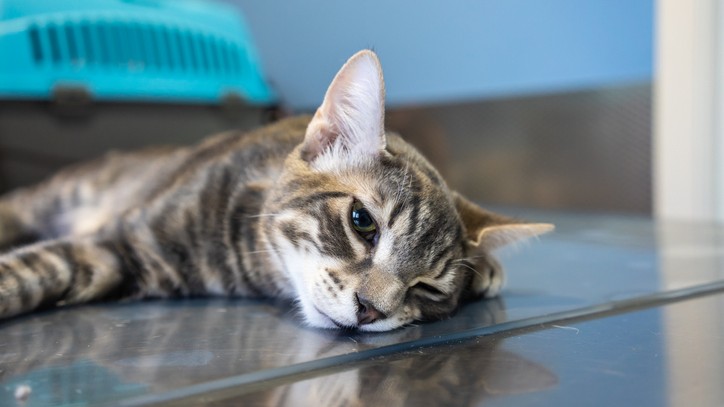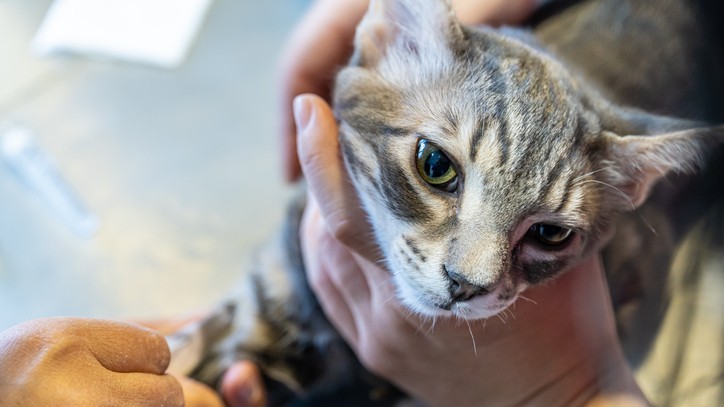Cat sedatives: Vet's guide to uses and sedating at home
Is your anxious kitty a handful? Cat sedatives can help

Your cat may benefit from receiving cat sedatives if they get frightened at stressful but necessary events like going to the veterinary clinic or travelling. Or perhaps if they become aggressive when you’re trimming their nails or grooming them at home.
Oral sedatives from your veterinarian can help reduce your cat’s fear and anxiety and make the fractious cat easier to handle. Before your cat needs to be sedated, it’s important to first consult your veterinarian to develop a plan to sedate your cat safely and effectively. Read on to learn more about using sedatives in cats and how they can help your cat.
- Best cat carriers: Keep your cat cozy and safe on your travels
- Best pet insurance: Essential cover options
Why would a cat need to be sedated?
Your veterinarian may recommend sedating your cat for veterinary visits if your cat tends to be very fearful, anxious, or aggressive in the veterinary clinic.
This not only helps your cat feel less stressed, but also ensures your safety and that of the veterinary team when handling your cat. Most importantly, your cat will be less fearful and will have a more positive experience during his or her veterinary visit.
Similarly, sedation may also be used to keep a cat calm during travel, such as long car rides, or in stressful situations such as moving to a new home. A sedative can make this process go more smoothly for both cat and owner by mitigating the cat’s anxiety and reducing the cat’s fear in this new and potentially scary situation.
Veterinarians also use sedatives to anesthetize your cat for certain procedures or prior to surgery. This ensures that your cat is safe, comfortable, pain-free, and immobile during the procedure. These sedatives are administered at the veterinary clinic under the supervision of the veterinary team.
How is a cat sedated?
There are several ways a cat can be sedated. If your veterinarian has asked you to sedate your cat prior to a veterinary visit, you will be given pills or capsules to be administered to your cat by mouth at home.
Get the best advice, tips and top tech for your beloved Pets
These pills may be given the night before the appointment and/or a few hours prior to the appointment. This ensures that your cat will receive the full sedative effect when it is time for the appointment.
A similar process may be used for other stressful events, such as car rides, moving, thunderstorms, or other scary happenings. Be sure to follow your veterinarian’s dosing instructions closely so that your cat gets the full effect of the medication but does not receive an overdose.
After receiving oral sedation medications, your cat will be calmer, more relaxed, and maybe a little groggy. Your cat will not be fully anesthetized or “out of it”. The sedation medication is just enough to take the edge off of your cat’s anxiety and should not put him or her fully to sleep.
In the veterinary clinic, a cat is often sedated using injectable sedative medications. These anesthetic medications are used to facilitate certain procedures or to prepare your cat for surgery.
The medication is injected either intramuscularly (IM) or intravenously (IV). These medications will fully anesthetize your cat or put him or her to sleep so that the procedure can be safely performed.

Can I sedate my cat at home?
Your veterinarian may prescribe one or two medications for you to give to your cat at home to sedate your cat for an upcoming event such as a veterinary visit or a long car ride.
Be sure to follow your veterinarian’s instructions closely to get the maximum benefit from the sedation while ensuring your cat is safe. With your veterinarian’s permission, it’s best to test the sedative at home on a typical day first, so you’ll know exactly how the sedative will affect your cat prior to the big day.
Never try to sedate your cat at home using over the counter treatments or home remedies. Sedating your cat at home without your veterinarian’s guidance can be very dangerous for your cat.
If you feel your cat needs to be sedated, speak to your veterinarian first. Your veterinarian will give you a safe and effective plan for sedating your cat.
What happens after my cat is sedated?
After your cat is sedated with oral medications, he/she may be a little groggy, sleepy, or quieter than usual. Your cat will not be completely asleep or “flat out”, but will still be awake and aware of the world around him or her.
The sedation will simply help take the edge off of his or her fear and anxiety to make stressful events go more smoothly.
After the scary event is over, your cat may sleep more than normal or may want to hide and be alone until the sedation has worn off. Once the sedation has worn off – usually within a few hours to a day – your cat will be back to his or her normal, happy self.
Summary
Veterinary visits, car rides, thunderstorms – whenever you may need to sedate your cat, make sure you’re doing it safely and effectively. Follow your veterinarian’s instructions to sedate your cat safely, and only use medications or supplements given to you by your veterinarian.
Be sure to follow your vet’s dosing instructions exactly, and never double the dose or re-dose your cat without first consulting your vet for instructions. Never use over the counter medications or home remedies to sedate a cat, as these may be dangerous for your cat, particularly if dosed incorrectly.
If you have any questions about sedating your cat or helping your cat through stressful experiences, contact your veterinarian for further advice.
Dr. Elizabeth Racine is a small animal general practice vet covering all things pet health and wellness. Her special interests include veterinary behavior, nutrition, and internal medicine.
As a freelance writer, Dr. Racine has written content for major companies in the industry such as the American Kennel Club, Merck Animal Health, Bayer PetBasics, Elanco, and CareCredit. In her free time, Dr. Racine enjoys playing trampoline dodgeball, hiking with her beagle Dasher, and spending time with her three mischievous cats.

